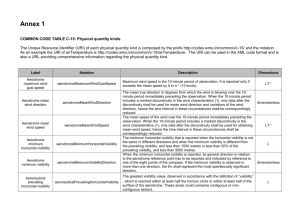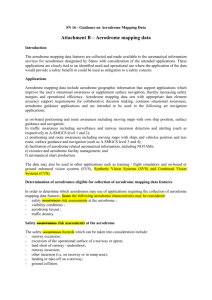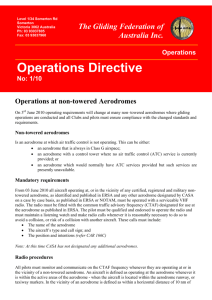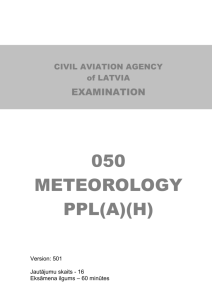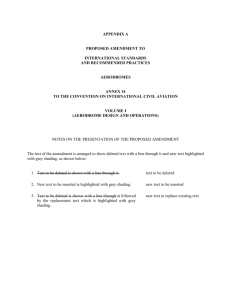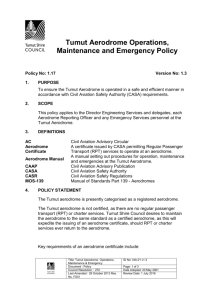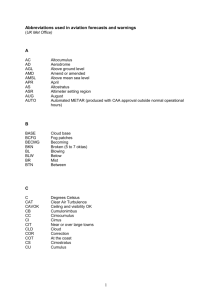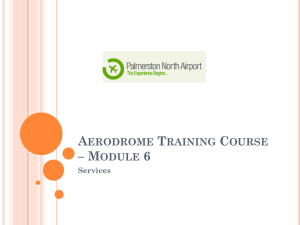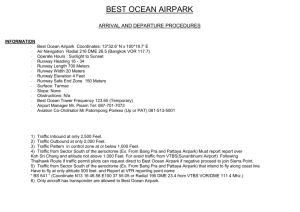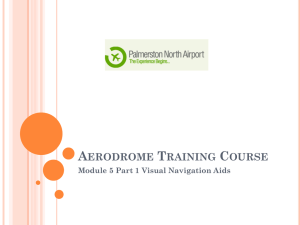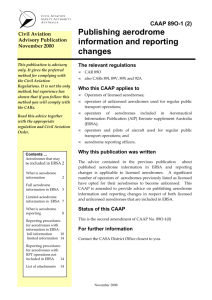Attachment XX – Aerodrome mapping data
advertisement
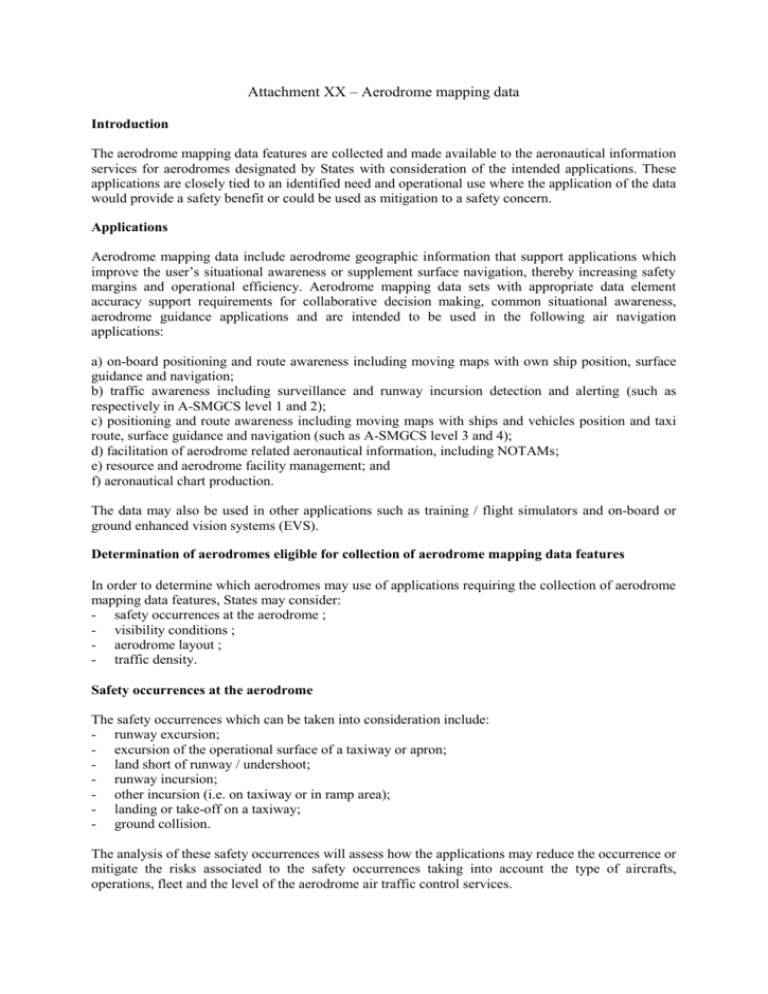
Attachment XX – Aerodrome mapping data Introduction The aerodrome mapping data features are collected and made available to the aeronautical information services for aerodromes designated by States with consideration of the intended applications. These applications are closely tied to an identified need and operational use where the application of the data would provide a safety benefit or could be used as mitigation to a safety concern. Applications Aerodrome mapping data include aerodrome geographic information that support applications which improve the user’s situational awareness or supplement surface navigation, thereby increasing safety margins and operational efficiency. Aerodrome mapping data sets with appropriate data element accuracy support requirements for collaborative decision making, common situational awareness, aerodrome guidance applications and are intended to be used in the following air navigation applications: a) on-board positioning and route awareness including moving maps with own ship position, surface guidance and navigation; b) traffic awareness including surveillance and runway incursion detection and alerting (such as respectively in A-SMGCS level 1 and 2); c) positioning and route awareness including moving maps with ships and vehicles position and taxi route, surface guidance and navigation (such as A-SMGCS level 3 and 4); d) facilitation of aerodrome related aeronautical information, including NOTAMs; e) resource and aerodrome facility management; and f) aeronautical chart production. The data may also be used in other applications such as training / flight simulators and on-board or ground enhanced vision systems (EVS). Determination of aerodromes eligible for collection of aerodrome mapping data features In order to determine which aerodromes may use of applications requiring the collection of aerodrome mapping data features, States may consider: - safety occurrences at the aerodrome ; - visibility conditions ; - aerodrome layout ; - traffic density. Safety occurrences at the aerodrome The safety occurrences which can be taken into consideration include: - runway excursion; - excursion of the operational surface of a taxiway or apron; - land short of runway / undershoot; - runway incursion; - other incursion (i.e. on taxiway or in ramp area); - landing or take-off on a taxiway; - ground collision. The analysis of these safety occurrences will assess how the applications may reduce the occurrence or mitigate the risks associated to the safety occurrences taking into account the type of aircrafts, operations, fleet and the level of the aerodrome air traffic control services. Visibility conditions If the aerodrome operations take place in all visibility conditions, an A-SMGCS or on-board aerodrome navigation system may improve the safety and maintain the runway throughput in low visibility conditions. Consequently, the number of low visibility days per year is a key factor. An aerodrome with no low visibility conditions does not need the same type ASMGCS level or AMDB quality as an aerodrome with a substantial number of days of fog for instance. 4 levels of visibility conditions can be considered: - condition 1: visibility sufficient for the pilot to taxi and to avoid collision with other traffic on taxiways and at intersections by visual reference, and for personnel of control units to exercise control over all traffic on the basis of visual surveillance ; - condition 2: visibility sufficient for the pilot to taxi and to avoid collision with other traffic on taxiways and at intersections by visual reference, but insufficient for personnel of control units to exercise control over all traffic on the basis of visual surveillance ; - condition 3: visibility sufficient for the pilot to taxi but insufficient for the pilot to avoid collision with other traffic on taxiways and at intersections by visual reference with other traffic, and insufficient for personnel of control units to exercise control over all traffic on the basis of visual surveillance. For taxiing this is normally taken as visibilities equivalent to a RVR less than 400 m but more than 75 m; - condition 4: visibility insufficient for the pilot to taxi by visual guidance only. This is normally taken as a RVR of 75 m or less. In order to simplify, we consider that visibility conditions 3 and 4 represent low visibility conditions and that an aerodrome is affected by low visibility conditions when conditions 3 and 4 are met during more than 15 days per year. Aerodrome layout A complex aerodrome layout requires close attention from the air traffic controllers and from the pilots and vehicle drivers. In particular in adverse weather conditions the complexity of an aerodrome can provoke high stress situations for the tower controllers and can lead to misinterpretations and false estimations by pilots and drivers. The following categories of aerodrome layout basic, simple, complex can be used: - Basic: An aerodrome with one runway and one taxiway to one apron area ; - Simple: An aerodrome with one runway, having more than one taxiway to one or more apron areas ; - Complex: An aerodrome with more than one runway, having many taxiways to one or more apron areas. Some other parameters need also to be considered to make a layout complex: - an aerodrome has a great number of entry taxiways for a runway ; - an aerodrome has a great number of exit taxiways, and particularly rapid exit taxiways, for a given runway ; - an aerodrome has a taxiway system with a great number of intersections. Especially in bad weather conditions, a false estimation by pilots or drivers is possible and likely to occur ; - a taxiway has to be shared by landing and departing aircraft or by aircraft and vehicles at the same time. These situations occur when the aerodrome has an adverse location with reference to the runway ; - the location of the air traffic control tower is such that the visibility of the runways, taxiways or aprons is hampered by buildings, by the relief or by sheer distance. Traffic density This criteria addresses the aerodrome characteristics in terms of traffic movements level and structure. The following aerodrome categories provide a means to assess the traffic density which takes into account the mean peak hour: - Light traffic which is characterised by a peak not greater than 15 take-offs or landings per runway or typically less than 20 total aerodrome movements; - Medium traffic which is characterised by a peak comprised between 16 to 25 take-offs or landings per runway or typically between 20 to 35 total aerodrome movements; - Heavy traffic which is characterised by a peak of 26 or more take-offs or landings per runway or typically more than 35 total aerodrome movements. The traffic density parameter could be complemented by the notion of the annual number of movements. This figure is useful to establish a ranking among aerodromes. Above a certain threshold one can consider that the traffic management requires specific tools to achieve an efficient use of the nominal aerodrome capacity. According to ICAO traffic density and ATC experience, two thresholds can be defined to distinguish the light / medium / heavy aerodromes, as follows: - First threshold light / medium : between 40 000 and 60 000 movements per year - Second threshold medium / heavy : between 140 000 and 160 000 movements per year For instance, an aerodrome with 100 000 movements per year is between both categories. It should be noticed that this notion is compatible with the ICAO traffic density categories. Another aspect is the mix of arriving and departing movements on the aerodrome that means crossing flows of aircraft going to and from different aprons or parking areas. This situation increases the risks of conflict on the aerodrome. It could also be noticed that there is a strong correlation with the weather conditions which increase the size of the problem as they worsen to the limit of VFR operation. In adverse weather conditions such as low visibility, the surface traffic on the aforementioned aerodromes is further reduced by the absence of VFR flights. Therefore the tower controllers are able to focus their concentration on the guidance of the mobiles.
